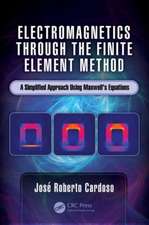Cognitive Radio Networks: Efficient Resource Allocation in Cooperative Sensing, Cellular Communications, High-Speed Vehicles, and Smart Grid
Autor Tao Jiang, Zhiqiang Wang, Yang Caoen Limba Engleză Hardback – 8 apr 2015
Cognitive radio networks are composed of cognitive, spectrum-agile devices capable of changing their configuration on the fly based on the spectral environment. This capability makes it possible to design flexible and dynamic spectrum access strategies with the purpose of opportunistically reusing portions of the spectrum temporarily vacated by licensed primary users. Different cognitive radio-based networks focus on different network resources, such as transmission slots, sensing nodes, transmission power, white space, and sensing channels.
This book introduces several innovative resource allocation schemes for different cognitive radio-based networks according to their network characteristics:
- Opportunistic spectrum access networks – Introduces a probabilistic slot allocation scheme to effectively allocate the transmission slots to secondary users to maximize throughput
- Cooperative sensing networks – Introduces a new adaptive collaboration sensing scheme in which the resources of secondary users are effectively utilized to sense the channels for efficient acquisition of spectrum opportunities
- Cellular networks – Introduces a framework of cognitive radio-assisted cooperation for downlink transmissions to allocate transmission modes, relay stations, and transmission power/sub-channels to secondary users to maximize throughput
- High-speed vehicle networks – Introduces schemes to maximize the utilized TV white space through effective allocation of white space resources to secondary users
- Smart grids – Introduces effective sensing channel allocation strategies for acquiring enough available spectrum channels for communications between utility and electricity consumers
| Toate formatele și edițiile | Preț | Express |
|---|---|---|
| Paperback (1) | 301.43 lei 6-8 săpt. | |
| CRC Press – 30 iun 2020 | 301.43 lei 6-8 săpt. | |
| Hardback (1) | 650.81 lei 6-8 săpt. | |
| CRC Press – 8 apr 2015 | 650.81 lei 6-8 săpt. |
Preț: 650.81 lei
Preț vechi: 837.83 lei
-22% Nou
Puncte Express: 976
Preț estimativ în valută:
124.55€ • 129.55$ • 102.82£
124.55€ • 129.55$ • 102.82£
Carte tipărită la comandă
Livrare economică 14-28 aprilie
Preluare comenzi: 021 569.72.76
Specificații
ISBN-13: 9781498721134
ISBN-10: 1498721133
Pagini: 148
Ilustrații: 71 black & white illustrations, 5 black & white tables
Dimensiuni: 156 x 234 x 15 mm
Greutate: 0.34 kg
Ediția:1
Editura: CRC Press
Colecția CRC Press
ISBN-10: 1498721133
Pagini: 148
Ilustrații: 71 black & white illustrations, 5 black & white tables
Dimensiuni: 156 x 234 x 15 mm
Greutate: 0.34 kg
Ediția:1
Editura: CRC Press
Colecția CRC Press
Cuprins
Introduction. Transmission Slots Allocation in an Opportunistic Spectrum Access Network. Sensing Nodes Allocation in a Cognitive Radio Network with Cooperative Sensing. Transmission Power Allocation in a Cognitive Radio Network. White Space Allocation in a Cognitive Radio-Based High-Speed Vehicle Network. Sensing Channel Allocation in a Cognitive Radio Network for a Smart Grid.
Notă biografică
Tao Jiang is currently a chair professor in the School of Electronics Information and Communications, Huazhong University of Science and Technology, Wuhan, P. R. China (PRC). He received the Ph.D. degree in information and communication engineering from Huazhong University of Science and Technology, Wuhan, PRC in April 2004. He has authored or co-authored over 200 technical papers in major journals and conferences and six books/chapters in the areas of communications and networks. He served or is serving as associate editor of some technical journals in communications, including IEEE Transactions on Signal Processing, IEEE Communications Surveys and Tutorials, IEEE Transactions on Vehicular Technology, and IEEE Internet of Things Journal. He is a recipient of the NSFC for Distinguished Young Scholars Award in PRC.
Zhiqiang Wang currently works at State Grid Shaanxi Electric Power Company Telematics. He received a B.S. from Xian Jiaotong University, Xian, PRC in 2006, and M.S. and Ph.D. degrees from Huazhong University of Science and Technology, Wuhan, PRC in 2009 and 2012, respectively. Wang’s current research interests include the areas of energy management and smart grid communications.
Yang Cao is currently an assistant professor in School of Electronics Information and Communications, Huazhong University of Science and Technology, Wuhan, PRC. He received Ph.D. and B.S. degrees in information and communications engineering at Huazhong University of Science and Technology, Wuhan, PRC in 2014 and 2009, respectively. His research interests include resource allocation for cellular device-to-device communications and smart grids.
Zhiqiang Wang currently works at State Grid Shaanxi Electric Power Company Telematics. He received a B.S. from Xian Jiaotong University, Xian, PRC in 2006, and M.S. and Ph.D. degrees from Huazhong University of Science and Technology, Wuhan, PRC in 2009 and 2012, respectively. Wang’s current research interests include the areas of energy management and smart grid communications.
Yang Cao is currently an assistant professor in School of Electronics Information and Communications, Huazhong University of Science and Technology, Wuhan, PRC. He received Ph.D. and B.S. degrees in information and communications engineering at Huazhong University of Science and Technology, Wuhan, PRC in 2014 and 2009, respectively. His research interests include resource allocation for cellular device-to-device communications and smart grids.
Descriere
Resource allocation is an important issue in wireless communication networks. In recent decades, cognitive radio-based networks have garnered increased attention and have been well studied to overcome the problem of spectrum scarcity in future wireless communication systems. Many new challenges in resource allocation appear in cognitive radio-based networks. This book focuses on effective resource allocation solutions in several important cognitive radio-based networks, including opportunistic spectrum access networks, cooperative sensing networks, cellular networks, high-speed vehicle networks, and smart grids.
















